
A more recent article on generalized anxiety disorder and panic disorder in adults is available.
Am Fam Physician. 2015;91(9):617-624
Patient information: See related handout on anxiety and panic disorders, written by the authors of this article.
Author disclosure: No relevant financial affiliations.
Generalized anxiety disorder (GAD) and panic disorder (PD) are among the most common mental disorders in the United States, and they can negatively impact a patient's quality of life and disrupt important activities of daily living. Evidence suggests that the rates of missed diagnoses and misdiagnosis of GAD and PD are high, with symptoms often ascribed to physical causes. Diagnosing GAD and PD requires a broad differential and caution to identify confounding variables and comorbid conditions. Screening and monitoring tools can be used to help make the diagnosis and monitor response to therapy. The GAD-7 and the Severity Measure for Panic Disorder are free diagnostic tools. Successful outcomes may require a combination of treatment modalities tailored to the individual patient. Treatment often includes medications such as selective serotonin reuptake inhibitors and/or psychotherapy, both of which are highly effective. Among psychotherapeutic treatments, cognitive behavior therapy has been studied widely and has an extensive evidence base. Benzodiazepines are effective in reducing anxiety symptoms, but their use is limited by risk of abuse and adverse effect profiles. Physical activity can reduce symptoms of GAD and PD. A number of complementary and alternative treatments are often used; however, evidence is limited for most. Several common botanicals and supplements can potentiate serotonin syndrome when used in combination with antidepressants. Medication should be continued for 12 months before tapering to prevent relapse.
Generalized anxiety disorder (GAD) and panic disorder (PD) are among the most common mental disorders in the United States and are often encountered by primary care physicians. The hallmark of GAD is excessive, out-of-control worry, and PD is characterized by recurrent and unexpected panic attacks. Both conditions can negatively impact a patient's quality of life and disrupt important activities of daily living. The rates of missed diagnoses and misdiagnosis of GAD and PD are high, with symptoms often ascribed to physical causes.
This article reviews the diagnosis and management of GAD and PD in adults. Diagnosis and care of children and adolescents with these conditions require special considerations that are beyond the scope of this review.
| Clinical recommendation | Evidence rating | References |
|---|---|---|
| Physical activity is a cost-effective treatment for GAD and PD. | B | 16, 17 |
| Selective serotonin reuptake inhibitors are considered first-line therapy for GAD and PD. | B | 19, 20, 22 |
| To avoid relapse, medication should be continued for 12 months after symptoms improve before tapering. | C | 11 |
| When used in combination with antidepressants, benzodiazepines may speed recovery from anxiety-related symptoms but do not improve longer-term outcomes. Because benzodiazepines are associated with tolerance, they should be used only short term during crises. | B | 11, 28–30 |
| Psychotherapy can be as effective as medication for GAD and PD. Cognitive behavior therapy has the best level of evidence. | A | 11, 37 |
| Successful treatment requires tailoring options to individuals and may often include a combination of modalities. | C | 11, 37, 42 |
Epidemiology, Etiology, and Pathophysiology
The 12-month prevalence for GAD and PD among U.S. adults 18 to 64 years of age is 2.9% and 3.1%, respectively. In this population, the lifetime prevalence is 7.7% in women and 4.6% in men for GAD, and is 7.0% in women and 3.3% in men for PD.1
The etiology of GAD is not well understood. There are several theoretical models, each with varying degrees of empirical support. An underlying theme to several models is the dysregulation of worry. Emerging evidence suggests that patients with GAD may experience persistent activation of areas of the brain associated with mental activity and introspective thinking following worry-inducing stimuli.2 Twin studies suggest that environmental and genetic factors are likely involved.3
The etiology of PD is also not well understood. The neuroanatomical hypothesis suggests that a genetic-environment interaction is likely responsible. Patients with PD may exhibit irregularities in specific brain structures, altered neuronal processes, and dysfunctional corticolimbic interaction during emotional processing.4
Typical Presentation and Diagnostic Criteria
GENERALIZED ANXIETY DISORDER
Patients with GAD typically present with excessive anxiety about ordinary, day-today situations. The anxiety is intrusive, causes distress or functional impairment, and often encompasses multiple domains (e.g., finances, work, health). The anxiety is often associated with physical symptoms, such as sleep disturbance, restlessness, muscle tension, gastrointestinal symptoms, and chronic headaches.5 Diagnostic and Statistical Manual of Mental Disorders, 5th ed, (DSM-5) diagnostic criteria for GAD are listed in Table 1.5 Some factors associated with GAD include female sex, unmarried status, lower education level, poor health, and presence of life stressors.6 The age of onset is variable, with a median age of 30 years.1
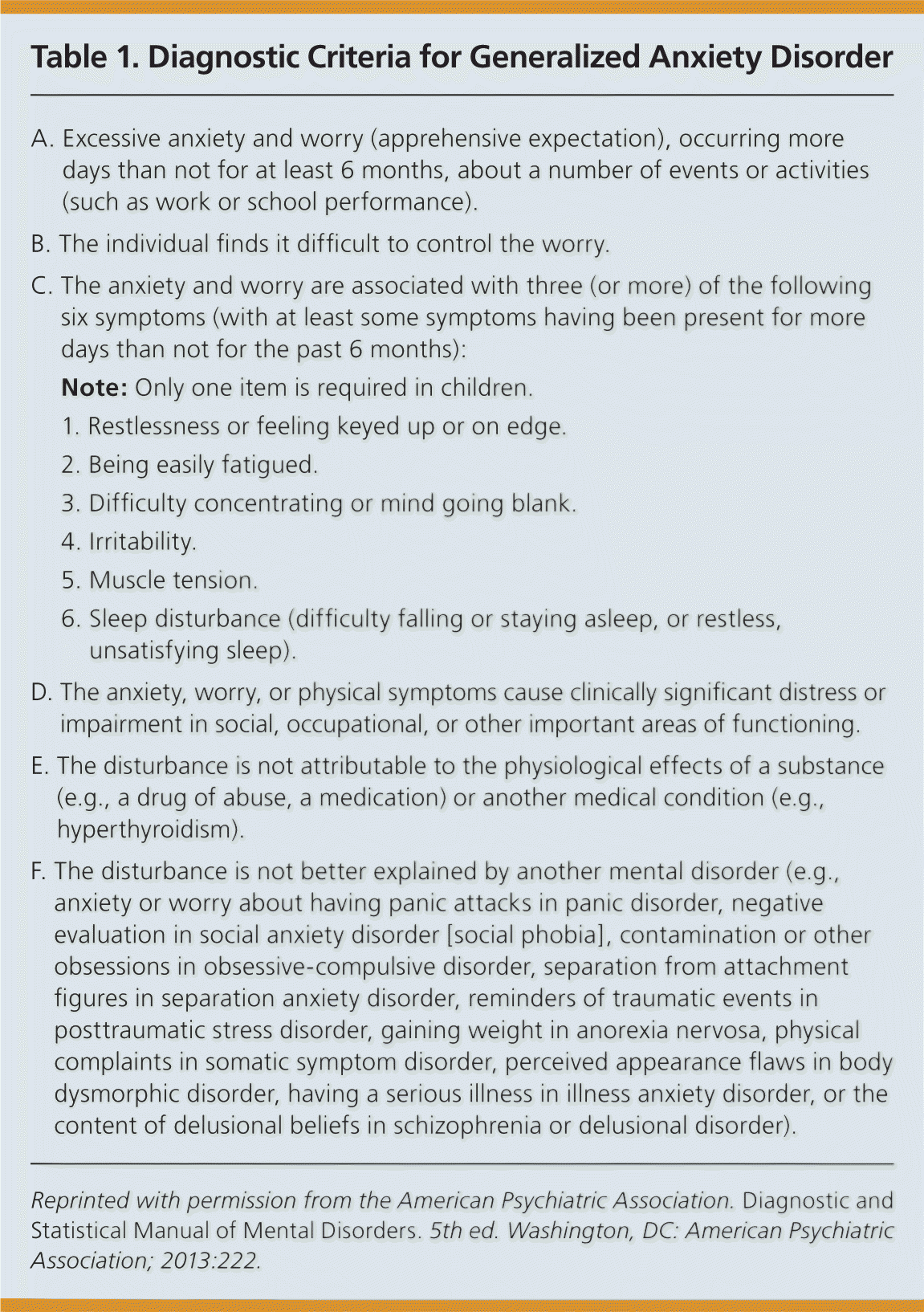
| A. Excessive anxiety and worry (apprehensive expectation), occurring more days than not for at least 6 months, about a number of events or activities (such as work or school performance). | |
| B. The individual finds it difficult to control the worry. | |
| C. The anxiety and worry are associated with three (or more) of the following six symptoms (with at least some symptoms having been present for more days than not for the past 6 months): | |
| Note: Only one item is required in children. | |
| 1. Restlessness or feeling keyed up or on edge. | |
| 2. Being easily fatigued. | |
| 3. Difficulty concentrating or mind going blank. | |
| 4. Irritability. | |
| 5. Muscle tension. | |
| 6. Sleep disturbance (difficulty falling or staying asleep, or restless, unsatisfying sleep). | |
| D. The anxiety, worry, or physical symptoms cause clinically significant distress or impairment in social, occupational, or other important areas of functioning. | |
| E. The disturbance is not attributable to the physiological effects of a substance (e.g., a drug of abuse, a medication) or another medical condition (e.g., hyperthyroidism). | |
| F. The disturbance is not better explained by another mental disorder (e.g., anxiety or worry about having panic attacks in panic disorder, negative evaluation in social anxiety disorder [social phobia], contamination or other obsessions in obsessive-compulsive disorder, separation from attachment figures in separation anxiety disorder, reminders of traumatic events in posttraumatic stress disorder, gaining weight in anorexia nervosa, physical complaints in somatic symptom disorder, perceived appearance flaws in body dysmorphic disorder, having a serious illness in illness anxiety disorder, or the content of delusional beliefs in schizophrenia or delusional disorder). | |
A number of scales are available to establish diagnosis and assess severity. The GAD-7 (Table 27 ) has been validated as a diagnostic tool and a severity assessment scale, with a score of 10 or more having good diagnostic sensitivity and specificity.8 Greater GAD-7 scores correlate with more functional impairment.8 The scale was developed and validated based on DSM-IV criteria, but it remains clinically useful after publication of the DSM-5 because the differences in GAD diagnostic criteria are minimal. The PRO-MIS Emotional Distress–Anxiety–Short Form for adults and the Severity Measure for Generalized Anxiety Disorder–Adult, available from the American Psychiatric Association at http://www.psychiatry.org/practice/dsm/dsm5/online-assessment-measures, are intended to aid clinical evaluation of GAD and monitor treatment effectiveness.
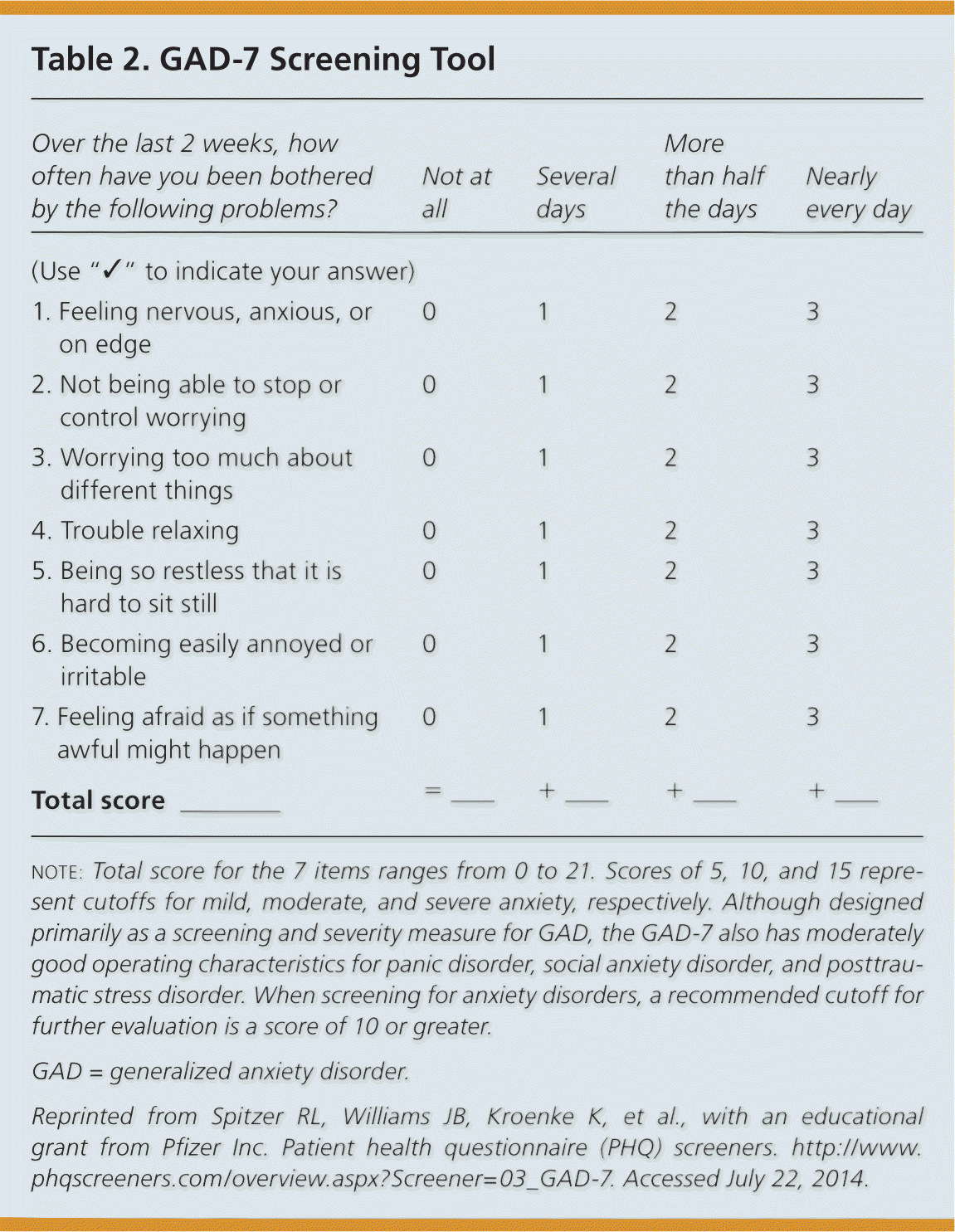
| Over the last 2 weeks, how often have you been bothered by the following problems? | Not at all | Several days | More than half the days | Nearly every day |
|---|---|---|---|---|
| (Use “✓” to indicate your answer) | ||||
| 1. Feeling nervous, anxious, or on edge | 0 | 1 | 2 | 3 |
| 2. Not being able to stop or control worrying | 0 | 1 | 2 | 3 |
| 3. Worrying too much about different things | 0 | 1 | 2 | 3 |
| 4. Trouble relaxing | 0 | 1 | 2 | 3 |
| 5. Being so restless that it is hard to sit still | 0 | 1 | 2 | 3 |
| 6. Becoming easily annoyed or irritable | 0 | 1 | 2 | 3 |
| 7. Feeling afraid as if something awful might happen | 0 | 1 | 2 | 3 |
| Total score_____ | =___ | +___ | +___ | +___ |
PANIC DISORDER
PD is characterized by episodic, unexpected panic attacks that occur without a clear trigger.5 Panic attacks are defined by the rapid onset of intense fear (typically peaking within about 10 minutes) with at least four of the physical and psychological symptoms in the DSM-5 diagnostic criteria (Table 3).5 Another requirement for the diagnosis of PD is that the patient worries about further attacks or modifies his or her behavior in maladaptive ways to avoid them. The most common physical symptom accompanying panic attacks is palpitations.9 Although unexpected panic attacks are required for the diagnosis, many patients with PD also have expected panic attacks, occurring in response to a known trigger.9 The Severity Measure for Panic Disorder–Adult (http://www.psychiatry.org/File%20Library/Practice/DSM/DSM-5/SeverityMeasureForPanicDisorderAdult.pdf) is an assessment scale that can complement the clinical assessment of patients with PD.
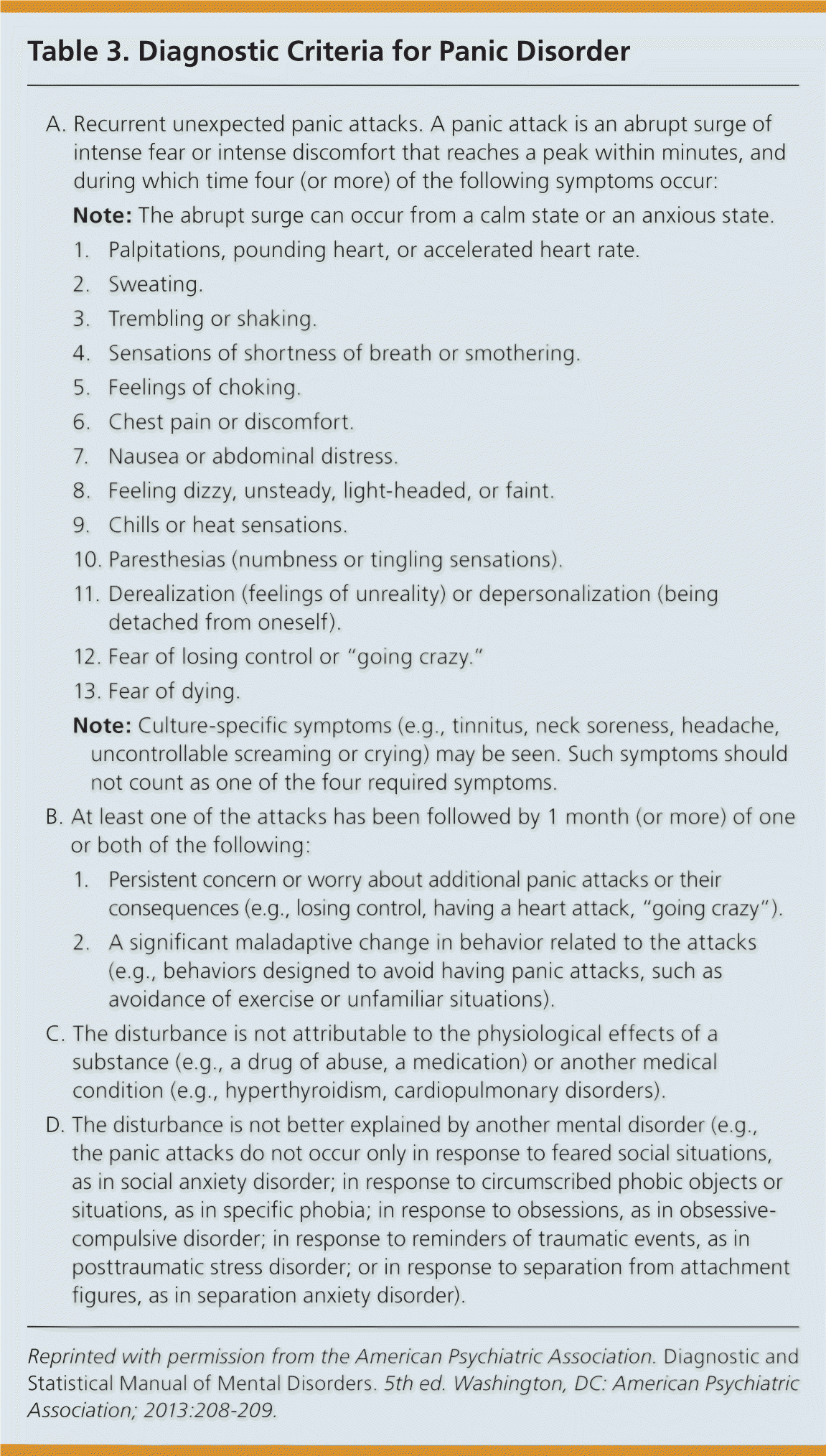
| A. Recurrent unexpected panic attacks. A panic attack is an abrupt surge of intense fear or intense discomfort that reaches a peak within minutes, and during which time four (or more) of the following symptoms occur: | |
| Note: The abrupt surge can occur from a calm state or an anxious state. | |
| 1. Palpitations, pounding heart, or accelerated heart rate. | |
| 2. Sweating. | |
| 3. Trembling or shaking. | |
| 4. Sensations of shortness of breath or smothering. | |
| 5. Feelings of choking. | |
| 6. Chest pain or discomfort. | |
| 7. Nausea or abdominal distress. | |
| 8. Feeling dizzy, unsteady, light-headed, or faint. | |
| 9. Chills or heat sensations. | |
| 10. Paresthesias (numbness or tingling sensations). | |
| 11. Derealization (feelings of unreality) or depersonalization (being detached from oneself). | |
| 12. Fear of losing control or “going crazy.” | |
| 13. Fear of dying. | |
| Note: Culture-specific symptoms (e.g., tinnitus, neck soreness, headache, uncontrollable screaming or crying) may be seen. Such symptoms should not count as one of the four required symptoms. | |
| B. At least one of the attacks has been followed by 1 month (or more) of one or both of the following: | |
| 1. Persistent concern or worry about additional panic attacks or their consequences (e.g., losing control, having a heart attack, “going crazy”). | |
| 2. A significant maladaptive change in behavior related to the attacks (e.g., behaviors designed to avoid having panic attacks, such as avoidance of exercise or unfamiliar situations). | |
| C. The disturbance is not attributable to the physiological effects of a substance (e.g., a drug of abuse, a medication) or another medical condition (e.g., hyperthyroidism, cardiopulmonary disorders). | |
| D. The disturbance is not better explained by another mental disorder (e.g., the panic attacks do not occur only in response to feared social situations, as in social anxiety disorder; in response to circumscribed phobic objects or situations, as in specific phobia; in response to obsessions, as in obsessive-compulsive disorder; in response to reminders of traumatic events, as in posttraumatic stress disorder; or in response to separation from attachment figures, as in separation anxiety disorder). | |
Differential Diagnosis and Comorbidity
When evaluating a patient for a suspected anxiety disorder, it is important to exclude medical conditions with similar presentations (e.g., endocrine conditions such as hyperthyroidism, pheochromocytoma, or hyperparathyroidism; cardiopulmonary conditions such as arrhythmia or obstructive pulmonary diseases; neurologic diseases such as temporal lobe epilepsy or transient ischemic attacks). Other psychiatric disorders (e.g., other anxiety disorders, major depressive disorder, bipolar disorder); use of substances such as caffeine, albuterol, levothyroxine, or decongestants; or substance withdrawal may also present with similar symptoms and should be ruled out.5
Complicating the diagnosis of GAD and PD is that many conditions in the differential diagnosis are also common comorbidities. Additionally, many patients with GAD or PD meet criteria for other psychiatric disorders, including major depressive disorder and social phobia. Evidence suggests that GAD and PD usually occur with at least one other psychiatric disorder, such as mood, anxiety, or substance use disorders.10 When anxiety disorders occur with other conditions, historic, physical, and laboratory findings may be helpful in distinguishing each diagnosis and developing appropriate treatment plans.
Treatment
Some studies evaluating anxiety treatments assess non-specific anxiety-related symptoms rather than the set of symptoms that characterize GAD or PD. When possible, the treatments described in this section will differentiate between GAD and PD; otherwise, treatments refer to anxiety-related symptoms in general.
Medication or psychotherapy is a reasonable initial treatment option for GAD and PD.11 Some studies suggest that combining medication and psychotherapy may be more effective for patients with moderate to severe symptoms.12 The National Institute for Health and Care Excellence (NICE) guidelines on GAD and PD in adults are a useful review of available evidence; however, information about self-help and group therapies may have less utility in the United States because of their relative lack of availability.11
EDUCATION
Compassionate listening and education are an important foundation in the treatment of anxiety disorders.11 Patient education itself can help reduce anxiety, particularly in PD.13 The establishment of a therapeutic alliance between the patient and physician is important to allay fears of interventions and to progress toward treatment.
Common lifestyle recommendations that may reduce anxiety-related symptoms include identifying and removing possible triggers (e.g., caffeine, stimulants, nicotine, dietary triggers, stress), and improving sleep quality/quantity and physical activity.
Caffeine can trigger PD and other types of anxiety. Those with PD may be more sensitive to caffeine than the general population because of genetic polymorphisms in adenosine receptors.14 Smoking cessation leads to improved anxiety scores, with relapse leading to increased anxiety. Many studies show an association between disordered sleep and anxiety, but causality is unclear.15 In addition to decreased depression and anxiety, physical activity is associated with improved physical health, life satisfaction, cognitive functioning, and psychological well-being. Physical activity is a cost-effective approach in the treatment of GAD and PD.16,17 Exercising at 60% to 90% of maximal heart rate for 20 minutes three times weekly has been shown to decrease anxiety16; yoga is also effective.18
MEDICATION
First-Line Therapies. A number of medications are available for treating anxiety (Table 4). Selective serotonin reuptake inhibitors (SSRIs) are generally considered first-line therapy for GAD and PD.19–22 Tricyclic antidepressants (TCAs) are better studied for PD, but are thought to be effective for both GAD and PD.19,20 In the treatment of PD, TCAs are as effective as SSRIs, but adverse effects may limit the use of TCAs in some patients.23 Venlafaxine, extended release, is effective and well tolerated for GAD and PD, whereas duloxetine (Cymbalta) has been adequately evaluated only for GAD.24 Azapirones, such as buspirone (Buspar), are better than placebo for GAD25 but do not appear to be effective for PD.26 Mixed evidence suggests bupropion (Wellbutrin) may have anxiogenic effects for some patients, thus warranting close monitoring if used for treatment of comorbid depression, seasonal affective disorder, or smoking cessation.27 Bupropion is not approved for the treatment of GAD or PD.
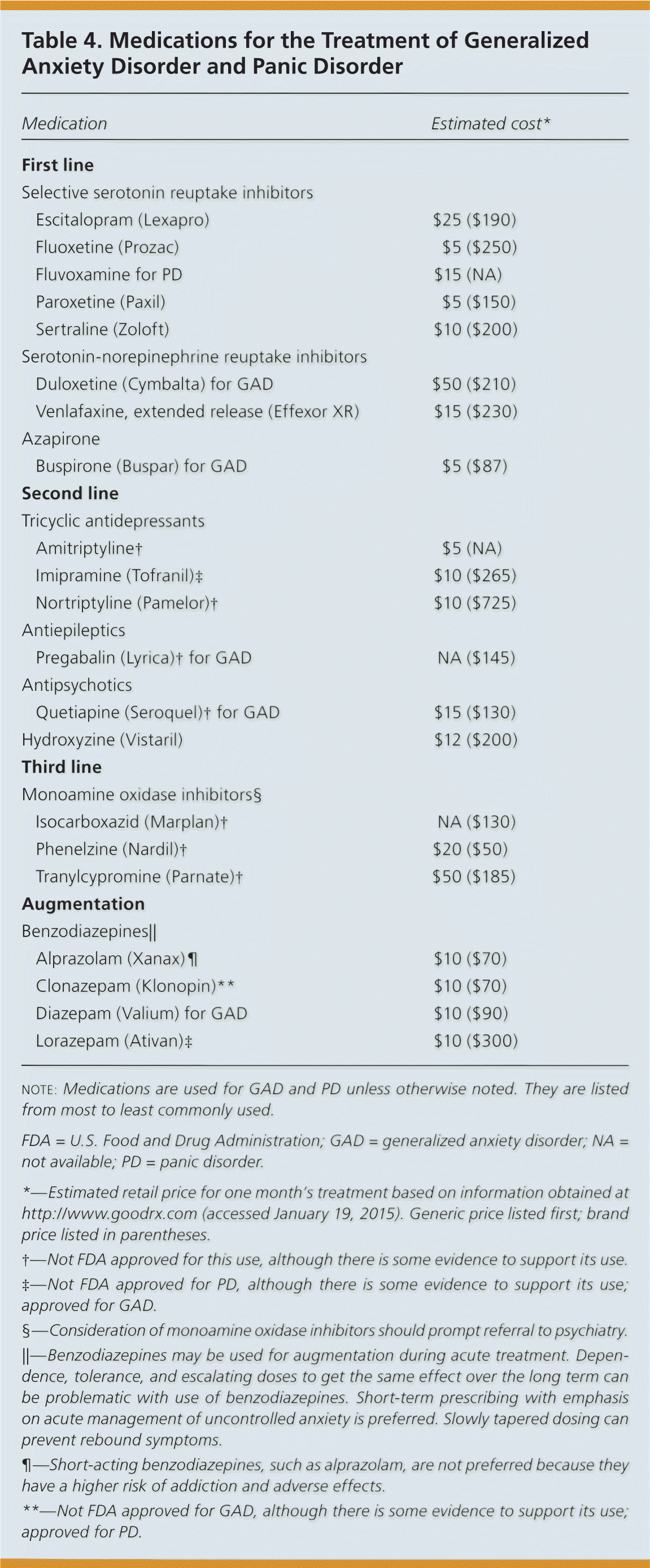
| Medication | Estimated cost* | |
|---|---|---|
| First line | ||
| Selective serotonin reuptake inhibitors | ||
| Escitalopram (Lexapro) | $25 ($190) | |
| Fluoxetine (Prozac) | $5 ($250) | |
| Fluvoxamine for PD | $15 (NA) | |
| Paroxetine (Paxil) | $5 ($150) | |
| Sertraline (Zoloft) | $10 ($200) | |
| Serotonin-norepinephrine reuptake inhibitors | ||
| Duloxetine (Cymbalta) for GAD | $50 ($210) | |
| Venlafaxine, extended release (Effexor XR) | $15 ($230) | |
| Azapirone | ||
| Buspirone (Buspar) for GAD | $5 ($87) | |
| Second line | ||
| Tricyclic antidepressants | ||
| Amitriptyline† | $5 (NA) | |
| Imipramine (Tofranil)‡ | $10 ($265) | |
| Nortriptyline (Pamelor)† | $10 ($725) | |
| Antiepileptics | ||
| Pregabalin (Lyrica)† for GAD | NA ($145) | |
| Antipsychotics | ||
| Quetiapine (Seroquel)† for GAD | $15 ($130) | |
| Hydroxyzine (Vistaril) | $12 ($200) | |
| Third line | ||
| Monoamine oxidase inhibitors§ | ||
| Isocarboxazid (Marplan)† | NA ($130) | |
| Phenelzine (Nardil)† | $20 ($50) | |
| Tranylcypromine (Parnate)† | $50 ($185) | |
| Augmentation | ||
| Benzodiazepines|| | ||
| Alprazolam (Xanax) ¶ | $10 ($70) | |
| Clonazepam (Klonopin)** | $10 ($70) | |
| Diazepam (Valium) for GAD | $10 ($90) | |
| Lorazepam (Ativan)‡ | $10 ($300) | |
Medications should be titrated slowly to decrease the initial activation. Because of the typical delay in onset of action, medications should not be considered ineffective until they are titrated to the high end of the dose range and continued for at least four weeks. Once symptoms have improved, medications should be used for 12 months before tapering to limit relapse.11 Some patients will require longer treatment.
Benzodiazepines are effective in reducing anxiety, but there is a dose-response relationship associated with tolerance, sedation, confusion, and increased mortality.28 When used in combination with antidepressants, benzodiazepines may speed recovery from anxiety-related symptoms but do not improve longer-term outcomes. The higher risk of dependence and adverse outcomes complicates the use of benzodiazepines.29 NICE guidelines recommend only short-term use during crises.11 Benzodiazepines with an intermediate to long onset of action (such as clonazepam [Klonopin]) may have less potential for abuse and less risk of rebound.30
Second-Line Therapies. Second-line therapies for GAD include pregabalin (Lyrica) and quetiapine (Seroquel), although neither has been evaluated for PD. Pregabalin is more effective than placebo but not as effective as lorazepam (Ativan) for GAD. Weight gain is a common adverse effect of pregabalin. There is limited evidence for the use of antipsychotics to treat anxiety disorders. Although quetiapine seems to be effective for GAD, the adverse effect profile is significant, including weight gain, diabetes mellitus, and hyperlipidemia.31 Hydroxyzine is considered a second-line treatment for GAD,32 but there are minimal data for its use in PD. Its rapid onset can be appealing for patients needing immediate relief, and it may be a more appropriate alternative if benzodiazepines are contraindicated (e.g., in patients with a history of substance abuse). Based on clinical experience, gabapentin (Neurontin) is sometimes prescribed by psychiatrists to treat anxiety on an as-needed basis when benzodiazepines are contraindicated. Of note, the placebo response for medications used to treat GAD and PD is high.13
PSYCHOTHERAPY AND RELAXATION THERAPIES
Psychotherapy includes many different approaches, such as cognitive behavior therapy (CBT) and applied relaxation (Table 5).33,34 CBT may use applied relaxation, exposure therapy, breathing, cognitive restructuring, or education. Psychotherapy is as effective as medication for GAD and PD.11 Although existing evidence is insufficient to draw conclusions about many psychotherapeutic interventions, structured CBT interventions have consistently proven effective for the treatment of anxiety in the primary care setting.34–36 Psychotherapy may be used alone or combined with medication as first-line treatment for PD37 and GAD,11 based on patient preference. Psychotherapy should be performed weekly for at least eight weeks to assess its effect.
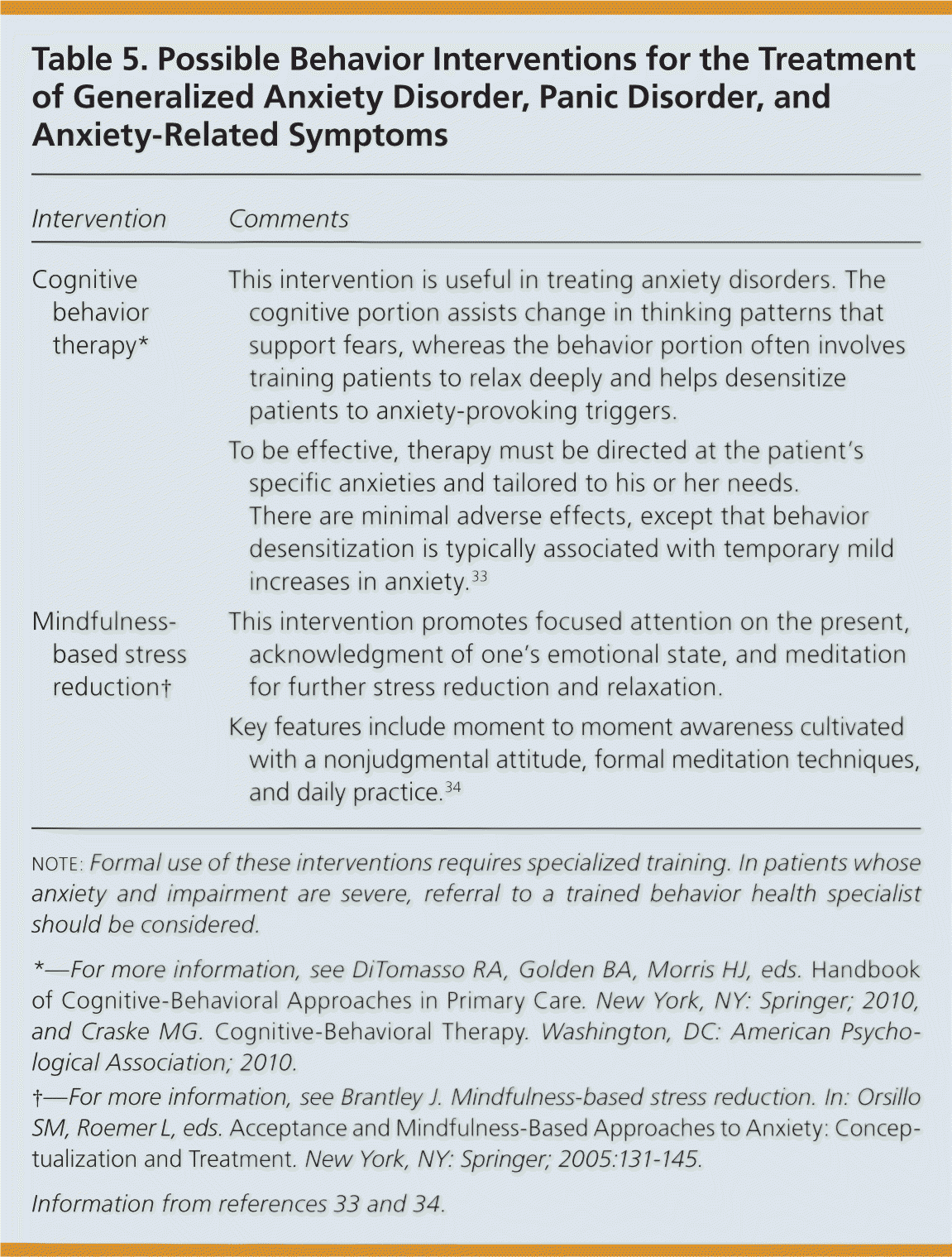
| Intervention | Comments |
|---|---|
| Cognitive behavior therapy* | This intervention is useful in treating anxiety disorders. The cognitive portion assists change in thinking patterns that support fears, whereas the behavior portion often involves training patients to relax deeply and helps desensitize patients to anxiety-provoking triggers. |
| To be effective, therapy must be directed at the patient's specific anxieties and tailored to his or her needs. There are minimal adverse effects, except that behavior desensitization is typically associated with temporary mild increases in anxiety.33 | |
| Mindfulness-based stress reduction† | This intervention promotes focused attention on the present, acknowledgment of one's emotional state, and meditation for further stress reduction and relaxation. |
| Key features include moment to moment awareness cultivated with a nonjudgmental attitude, formal meditation techniques, and daily practice.34 |
Mindfulness has similar effectiveness to traditional CBT or other behavior therapies,38 particularly mindfulness-based stress reduction.39 A meta-analysis of 36 randomized controlled trials on meditation showed that meditative therapies reduce anxiety symptoms, but most studies looked at anxiety symptoms rather than anxiety disorders.40 Transcendental meditation has similar effectiveness to other relaxation therapies.41
After a treatment course, rebound symptoms may occur less often with psychotherapy than with medications. Successful treatment requires tailoring options to individuals and may often include a combination of modalities.11,37,42 Combined treatment with medications and psychotherapy reduces relapse even at two years.43
COMPLEMENTARY AND ALTERNATIVE MEDICINE THERAPIES
Although a number of complementary and alternative products have evidence for treating depression, most lack sufficient evidence for the treatment of anxiety. Botanicals and supplements sometimes used to treat GAD and PD are listed in Table 6. Kava extract is an effective treatment for anxiety 44; however, case reports of hepatotoxicity have decreased its use.45 St. John's wort, tryptophan, 5-Hydroxytryptophan, and S-adenosyl-l-methionine should be used with caution in combination with SSRIs because of the increased risk of serotonin syndrome.46
Evidence indicates that music therapy, aromatherapy, acupuncture, and massage are helpful for anxiety associated with specific disease states, but none have been evaluated specifically for GAD or PD.
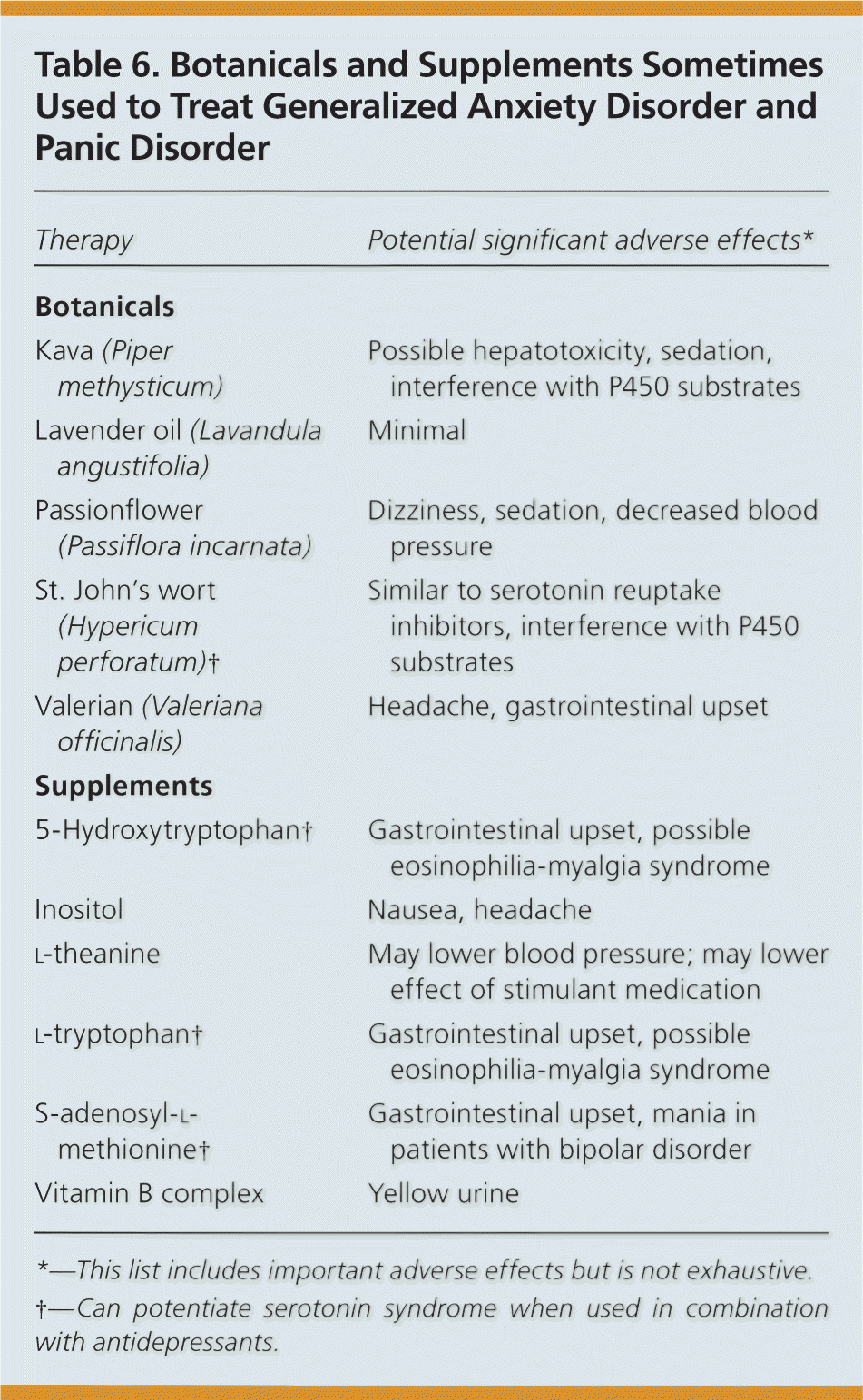
| Therapy | Potential significant adverse effects* |
|---|---|
| Botanicals | |
| Kava (Piper methysticum) | Possible hepatotoxicity, sedation, interference with P450 substrates |
| Lavender oil (Lavandula angustifolia) | Minimal |
| Passionflower (Passiflora incarnata) | Dizziness, sedation, decreased blood pressure |
| St. John's wort (Hypericum perforatum)† | Similar to serotonin reuptake inhibitors, interference with P450 substrates |
| Valerian (Valeriana officinalis) | Headache, gastrointestinal upset |
| Supplements | |
| 5-Hydroxytryptophan† | Gastrointestinal upset, possible eosinophilia-myalgia syndrome |
| Inositol | Nausea, headache |
| l-theanine | May lower blood pressure; may lower effect of stimulant medication |
| l-tryptophan† | Gastrointestinal upset, possible eosinophilia-myalgia syndrome |
| S-adenosyl-l-methionine† | Gastrointestinal upset, mania in patients with bipolar disorder |
| Vitamin B complex | Yellow urine |
Referral and Prevention
For patients with GAD or PD, psychiatric referral may be indicated if there is poor response to treatment, atypical presentation, or concern for significant comorbid psychiatric illness. There is insufficient evidence to support a concise recommendation on the prevention of PD and GAD in adults.
Data Sources: We searched Essential Evidence Plus, PubMed, and Ovid Medline using the keywords generalized anxiety disorder, panic disorder, diagnosis, treatment, medication, epidemiology, etiology, pathophysiology, differential diagnosis, and complementary and alternative medicine. We searched professional and authoritative organizations on the topic of anxiety disorders, including the American Psychological Association, the National Institute of Mental Health, the National Institute for Health and Care Excellence, and the Cochrane Collaboration. Search dates: May to July 2014.
